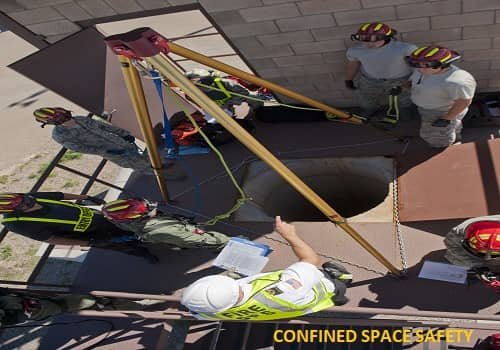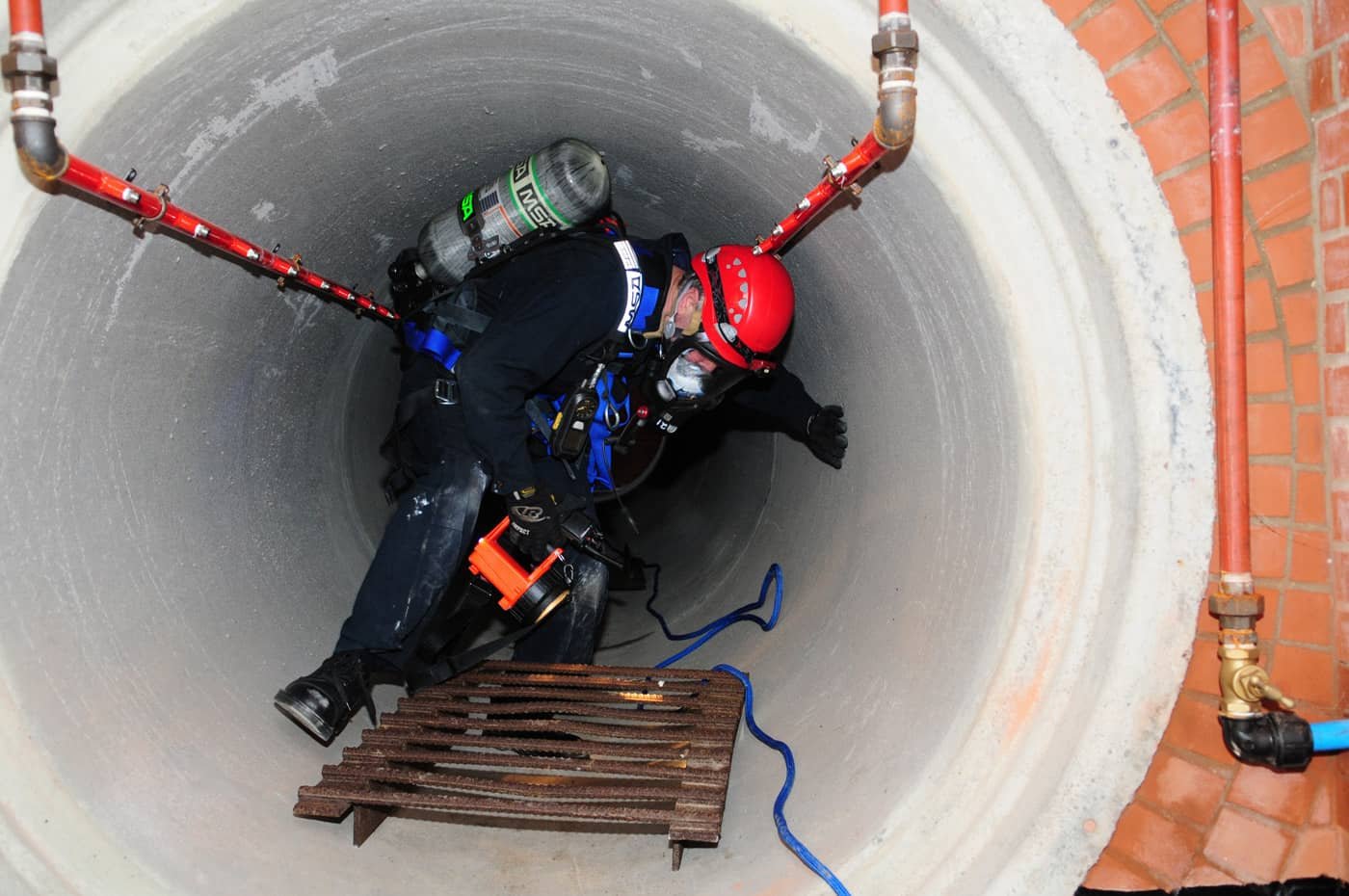SAFE MAINTENANCE PRACTICE- WORKING IN CONFINED SPACES
A confined space is the inside space of any tank, large
Contents
CONFINED SPACE HAZARDS
- Presence of toxic gases inside vessels or pipelines in harmful concentrations.
- Presence of explosive gases and mixtures inside the vessel pipeline, which may cause an explosion when heated or ignited by a flame.
- The danger of asphyxiation for want of oxygen for breathing due to the presence of a high percentage of solvent vapor or gas used for purging inside the vessel.
CLICK HERE FOR 👉 VESSEL ENTRY SAFETY
Safety precaution for entering in confined space

- Necessary work and safety permit must be obtained before anybody enters tanks, drums or other vessels. Should there be any doubt about the presence of gas while work is in progress, the work shall be stopped and arrangements made for conducting necessary gas test and investigations.
- Process operators shall take all possible steps to remove maximum amount of oil and gas from the vessel requiring the entry of personnel.
- Loose catalyst is a relatively poor conductor of heat so that while the surface of a pile of catalyst may be cool, the interior may be very hot. Hence care should be taken not to walk over catalyst lying on floor.
- Employees are not allowed to enter a vessel before gas tests are taken at various points throughout the vessel to determine whether or not any combustible or toxic gases are present. The general rule is that the vessel must be completely free of combustible and toxic gases before entry permit can be issued.
- Maximum ventilation shall be provided in all cases. This provision shall include removing cover plates from vessel and will also include installing mechanical ventilating equipment.
- Whenever work is done within a vessel it may become necessary to have someone standing by the vessel to render any help in the event of any emergency such as light hydrocarbons escaping in the area or other recognised conditions, which might jeopardize the safety of the employees working in the vessel.
- Where the vessel has contained tetra ethyl lead, either in the pure state or blended with gasoline, employee shall follow the added safety precautions specified in the operating manual.
- Tanks or vessels that contain or may contain self-igniting scales or other deposits that may ignite spontaneously must be kept wet until such materials have been removed or changed in such a manner that they will no longer ignite and cease to be a hazard.
The specific requirement for entry into a confined space based on the type of work (normally applicable if not mentioned otherwise)
CLICK HERE FOR 👉 EXCAVATION SAFETY
Unrestricted entry
- A joint inspection of all concerned in the work area is essential
- Complete lockout- mechanical as well as electrical
There is no exception to this rule
Blinds must be inserted immediately next to equipment or else no unrestricted entry.
- Equipment must be absolutely free from flammable and toxic gases or vapors.
- Adequate ventilation is essential.
- Can a combustible or toxic mixture develop during job execution? If the answer is yes, the entry can only be ‘Restricted Entry’ as below.
- What is the temperature inside the equipment? Would industrial air conditioning/ ventilating units provide extra comfort for maximum output?
What is Restricted entry in confined space
All condition of unrestricted entry is met except for the fact that combustible and/ or toxic gas may become airborne in the execution of the job, ie; tank cleaning when there is sludge on the bottom or if there is a possibility of release of hydrocarbon from the scale on the walls of the tank. Such an entry may be permitted on condition that:-
CLICK HERE FOR 👉 Work Permit System
- Presence of knowledgeable supervisor equipped with breathing apparatus.
- The gas test is done at regular, specified intervals
- Use of respiratory protection equipment
- Continuous forced ventilation
- Workers to be made aware of the hazards of the job
- Work to be suspended if the gas test indicates 50%LEL.
- Depending on ambient temperature and work environment intermittent work followed by a period of rest should be specified.
Confined space Entry where the hazard is immediate
The situation where the failure of breathing equipment would prove fatal or serious bodily harm can result from such entry should only be undertaken under extreme emergencies. The plant manager and maintenance manager must meet at the job site and determine various other alternatives.
If they decide to go ahead with the job, then express permission must be obtained from the unit head with the concurrence of the safety department. Normal requirements for such types of jobs are:

- Written and approved procedure in which all precautions and types of safety equipment to be used should be specified.
- There shall be no explosive mixture, ie; gas mixture too rich or below 50% LEL.
- Only breathing equipment approved for the situation where “hazard is immediate” shall be specified.
- All reasonable precautions to be taken to ensure the equipment does not get pressurized during job execution.
- Presence of operating and executing department managers.
- Every employee entering the confined area would be equipped with a safety harness and a lifeline.
- For every employee entering the confined area, there will be a safety watch stationed outside. The safety watch will be equipped with breathing apparatus and any other protective equipment to combat the hazard present in the confined area. He will hold the lifeline and keep the employee in his “responsibility” under constant surveillance.
- The number of people entering the confined area shall be kept to an absolute minimum.
- All breathing equipment must be tested before use.
CLICK HERE FOR 👉 HIRA AND JSA
Only the following breathing equipment may be used in a situation where the “Hazard is immediate”
- Breathing Apparatus set or any other self-breathing apparatus equipped with a
low-pressure alarm. - Manually operated blower type mask using 38mm(1 1/2) (min) non-percolating flexible hose.
- Supplied air mask is equipped with an escape air bottle.
Confined Space Entry where the hazard is not immediate
This is a situation where the failure of breathing equipment will not prove fatal or cause serious bodily harm. Most of our jobs requiring entry into a contaminated confined space come under this category. The following precautions should be enforced:
- Presence of operating and executing supervisors.
- There shall be no explosive mixture ie; gas mixture must be below 50% LEL.
- Any approved type of air-breathing equipment may be used.
- All reasonable precautions must be taken to ensure that the equipment does not get pressured up during job execution. If the complete lockout is not possible, the plant manager must be informed.
- Continuous forced ventilation to keep gas concentration below 50% LEL
- Every employee entering the confined area would be equipped with a safety harness and a Life-Line.
- The adequate number of safety watches must be stationed outside and equipped with breathing apparatus set.
The safety department should be contacted and take their services for all the above works.
Safety harness for confined spaces and Hazardous Areas

This shall be used for hoisting the wearer in a
The hoisting straps are so arranged that the hoisting ring has free movement and in the event of the user being hauled out he keeps his position vertical and his head does not obstruct the straps and the user should not suffer inconvenience, discomfort, or injury.
Provision for leg
IF YOU LIKE THIS ARTICLE (CONFINED SPACE HAZARDS AND SAFETY) PLEASE SHARE IT WITH YOUR SAFETY-PROFESSIONAL FRIENDS.
Also, read this:
Duties of confined space attendant






Thanks Sir,
hope this will be knowledge respository for us ,also request to all
please share actual process safety incident ,rootcause and action to all
this will help every one
Very much useful as previous others. Yourself is really such an Encyclopodia of SAFETY, which is being constantly updated. Hats off again.
Very good information to us
Thank You!!
Very useful
Hello sir please send me this data at murtazashah84@gmail.com i will be very thankful to you.
ok..
Dear Karan please provide road accidents safety related articles.
Dear we also publish transport safety.
<p>Good job Karan ji</p>
Thnx